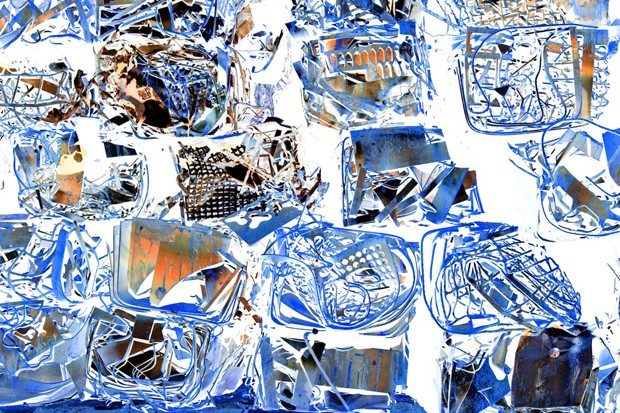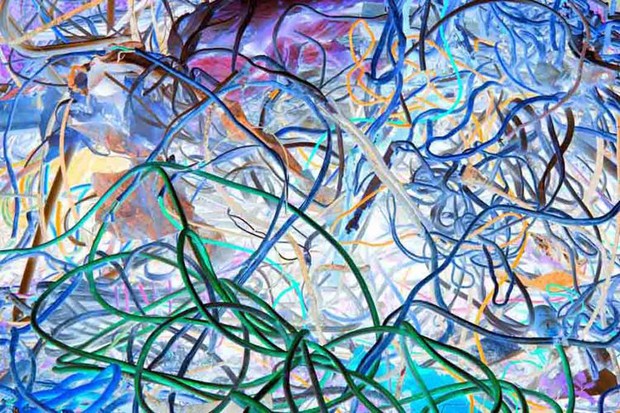Emilio Cresciani is an artist and freelance photographer. He graduated from Sydney College of the Arts in 2012 and his artwork explores redundancy and urban change. His interest is in objects, structures, buildings and the urban landscape.
Cresciani’s latest exhibition, Remains of the Day, is a close up of the different types of waste, including construction and demolition waste.
Architecture & Design spoke to him about his interest in garbage, photographing construction waste and working as an architecture photographer.
Can you tell A&D about Remains of the Day? How did the idea come about?
Remains of the Day is an exhibition at Willoughby’s Walter Burley Griffin-designed Incinerator Art Space (27 August – 14 September). The large-scale photographs are of different types of rubbish – tyre rims, circuit boards, hair dryers, bullet casings, TVs, wires and the other remains of our modern consumer lifestyle.
I photographed waste centres, tips and landfills around Sydney for over a year or so. The sheer scale of waste overwhelmed me but I also found beauty in the shapes and textures, and in the history and memories the rubbish evokes. And I could see my life in the piles of rubbish too – the things I throw away, like cans, bags, bottles, internet cables, memory cards and old TVs!

Where does your interest in waste come from?
I remember driving past large mountains of scrap metal on family holidays up the coast of NSW. I also like history, memory and redundancy and I wanted to capture life as it is now.
For me, waste is a portrait of our lives. Each week our garbage bins are emptied, and redundant, useless, broken, unfashionable or finished waste is collected. It’s the aftermath of life for that week. Where does it end up? Recycling yards and landfills are outside our daily experience but we are involved with them through the products we buy and throw away.
Do you have a particular approach when it comes to photographing construction waste?
My approach is similar to the other waste types I found. Amongst the mountains of rubbish I looked for patterns, textures and colours and I shot them as I found them.
I found that the shredded, squashed, cubed, jumbled and melted waste creates fascinating patterns and colour. This became the focus of the work. These patterns are random and accidental, in contrast to the planned, straight lines in buildings.
And experimenting with the images on my phone I found that inverting them as negatives created intriguing images, a bit like an x-ray which reveals the weakness or disease in our body.

What type of construction waste comes across well in photographs?
The Electrical Wires (pictured above) are mesmerising – a twisting, seething mass of wires that creates a lot of movement and leads your eye deep into the photo. The psychedelic colours also emphasise this.
I love the strong angles, sharp lines and edges of the Doorframes too, the cool metallic colours and the movement that this creates. It’s very intense.

Where does your interest in the built environment come from?
My grandparents lived in a Bruce Rickard house. My parents also work in the arts so design was always part of our family. I’ve always loved history and memory, and buildings speak. To me, they are large-scale sculptural forms.
You’ve worked with some architects and architecture photographer Richard Glover. What has been your favourite building to photograph and why?
 I shot the UTS at Kuringai for a course on architectural photography at the Australian Centre for Photography with Richard Glover. I really love the sculptural forms in brutalism, the monochromatic concrete and the texture. Shooting in black and white also highlights these qualities.
I shot the UTS at Kuringai for a course on architectural photography at the Australian Centre for Photography with Richard Glover. I really love the sculptural forms in brutalism, the monochromatic concrete and the texture. Shooting in black and white also highlights these qualities.
Capturing the curves, the light and the repetitive wall patterns of LAVA’s Greenland Centre was another fascinating shoot. I also photograph for ‘old buildings’ architect Hector Abrahams. I love the interior light of his church work and the way he works with the old and new.
What’s your favourite building around the world?
The building that got me into architectural photography in the first place was the 16th century Fondaco dei Tedeschi, now the post office in Venice. I was visiting the Venice Art Biennale in 2009 and came across the interior courtyard with its repetitive arches and loggias that gradually change in height and lighten the space.

